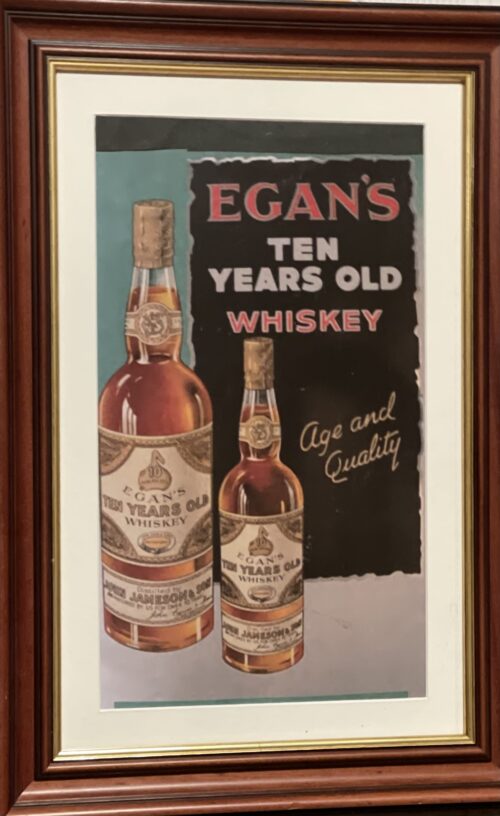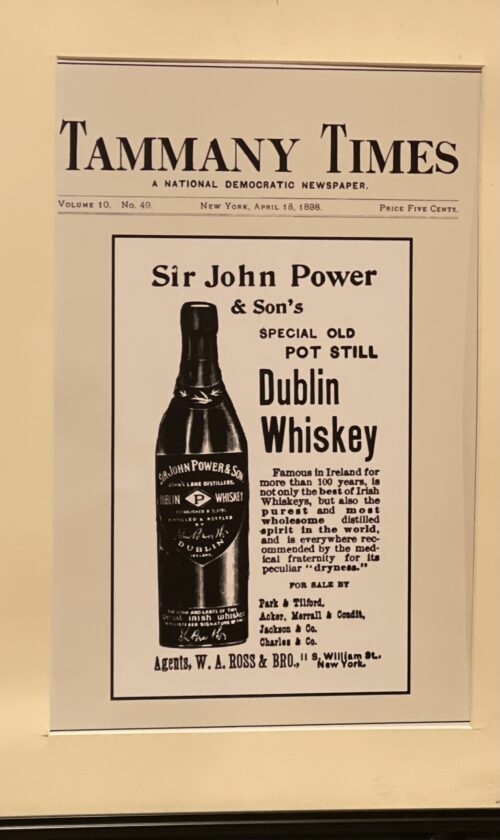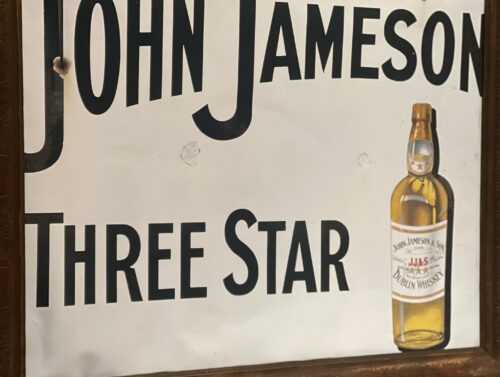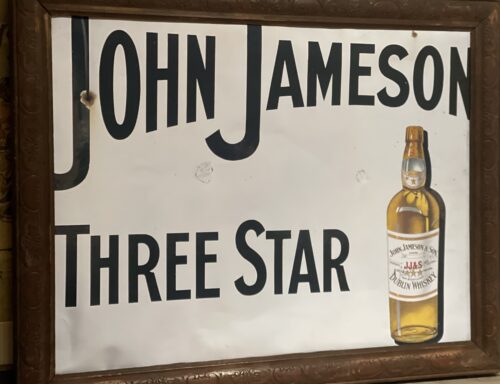Classic Jameson Irish Whiskey Horse Racing advertisement from 1951 with a picture of the Epsom Derby winner Arctic Prince being led into the winners enclosure by his proud owner,Irish businessman and Founder of the Irish Hospital Sweepstakes ,Mr Joe McGrath.
50cm x 43cm. Dublin
Joseph McGrath ( 12 August 1888 – 26 March 1966) was an Irish politician and businessman.
He was a
Sinn Féin and later a
Cumann na nGaedheal Teachta Dála (TD) for various constituencies
Dublin St James's (1918–21)
Dublin North West (1921–23) and
Mayo North (1923–27) and developed widespread business interests.

British Army military intelligence file for Joseph McGrath
McGrath was born in Dublin in 1888. By 1916 he was working with his brother George at
Craig Gardiner & Co, a firm of accountants in
Dawson Street, Dublin. He worked with
Michael Collins, a part-time fellow clerk and the two struck up a friendship. In his spare time McGrath worked as secretary for the Volunteer Dependents' Fund.
He soon joined the
Irish Republican Brotherhood. He fought in
Marrowbone Lane in the 1916
Easter Rising. McGrath was arrested after the rising, and jailed in
Wormwood Scrubs and
Brixton prisons in England. In the
1918 general election, he was elected as
Sinn Féin TD for the
Dublin St James's constituency, later sitting in the
First Dáil.
He was also a member of the
Irish Republican Army, the
guerrilla army of the
Irish Republic, and successfully organised many bank robberies during the
Irish war of Independence (1919–1921), where a small percentage of the proceeds was retained as a reward by him and his fellow-soldiers.
During this time he was interred briefly at
Ballykinlar Internment Camp. He escaped by dressing in army uniform and walking out of the gate with soldiers going on leave. He was eventually recaptured and spent time in jail in Belfast.
In October 1921 McGrath travelled with the Irish
Treaty delegation to London as one of
Michael Collins' personal staff. When the
Provisional Government of Ireland was set up in January 1922, McGrath was appointed as
Minister for Labour. In the
Irish Civil War of 1922–1923, he took the pro-treaty side and was made Director of Intelligence, replacing
Liam Tobin. In a strongly worded letter, written in red ink, McGrath warned Collins not to take his last, ill-fated trip to Cork.
He was later put in charge of the police Intelligence service of the new
Irish Free State, the
Criminal Investigation Department or CID. It was modelled on the London
Metropolitan Police department of the same name, but was accused of the torture and killing of a number of
republican (anti-treaty) prisoners during the civil war. It was disbanded at the war's end; the official reason given was that it was unnecessary for a police force in peacetime. McGrath went on to serve as
Minister for Labour in the
Second Dáil and the
Provisional Government of Ireland. He also served in the 1st and 2nd
Executive Councils holding the Industry and Commerce portfolio.
In September 1922 McGrath used
strikebreakers to oppose a strike by Trade Unionists in the Post Office service, despite having threatened to resign in the previous March of the same year when the government threatened to use British strikebreakers-four high profile IRA prisoners;
Liam Mellows,
Dick Barrett,
Rory O'Connor, and
Joe McKelvey.
McGrath resigned from office in April 1924 because of dissatisfaction with the government's attitude to the
Army Mutinyofficers and as he said himself,
"government by a clique and by the officialdom of the old regime." By this he meant that former IRA fighters were being overlooked and that the Republican goals on all Ireland had been sidelined.
McGrath and eight other TDs who had resigned from Cumann na nGaedheal then resigned their seats in the Dáil and formed a new political party,
the National Party. However, the new party did not contest the subsequent by-elections for their old seats. Instead, Cumann na nGaedheal won seven of the seats and Sinn Féin won the other two.
In 1927, McGrath took a libel case against the publishers of "The Real Ireland" by poet Cyril Bretherton, a book that claimed McGrath was responsible for the abduction and murder of
Noel Lemass (the brother of Seán Lemass) in June 1923 during the Civil war, as well as a subsequent coverup. McGrath won the court case. During the 1930s, McGrath and Seán Lemass reconciled and regularly played poker together.
Following his political career, he went on to become involved in the building trade. In 1925 he became labour adviser to
Siemens-Schuckert, German contractors for the
Ardnacrusha hydro-electric scheme near
Limerick. McGrath founded the
Irish Hospitals' Sweepstake in 1930, and the success of its sweepstakes made him an extremely wealthy man. He had other extensive and successful business interests always investing in Ireland and became Ireland's best-known racehorse owner and breeder, winning
The Derby with
Arctic Prince in 1951.
McGrath died at his home, Cabinteely House, in Dublin on 26 March 1966.
Cabinteely House, was donated to the state in 1986, and the land developed as a public park. Joe's son
Paddy McGrath inherited many of his father's business interests, and also served as Fine Gael Senator from 1973 to 1977.
John Jameson was originally a lawyer from Alloa in Scotland before he founded his eponymous distillery in Dublin in 1780.Prevoius to this he had made the wise move of marrying Margaret Haig (1753–1815) in 1768,one of the simple reasons being Margaret was the eldest daughter of John Haig, the famous whisky distiller in Scotland. John and Margaret had eight sons and eight daughters, a family of 16 children. Portraits of the couple by Sir Henry Raeburn are on display in the National Gallery of Ireland.
John Jameson joined the Convivial Lodge No. 202, of the Dublin Freemasons on the 24
th June 1774
and in 1780, Irish whiskey distillation began at Bow Street. In 1805, he was joined by his son John Jameson II who took over the family business that year
and for the next 41 years, John Jameson II built up the business before handing over to his son John Jameson the 3
rd in 1851. In 1901, the Company was formally incorporated as John Jameson and Son Ltd.
Four of John Jameson’s sons followed his footsteps in distilling in Ireland, John Jameson II (1773 – 1851) at Bow Street, William and James Jameson at Marrowbone Lane in Dublin (where they partnered their Stein relations, calling their business Jameson and Stein, before settling on William Jameson & Co.)
. The fourth of Jameson's sons, Andrew, who had a small distillery at Enniscorthy, Co. Wexford, was the grandfather of
Guglielmo Marconi, inventor of wireless telegraphy. Marconi’s mother was Annie Jameson, Andrew’s daughter.
John Jameson’s eldest son, Robert took over his father’s legal business in Alloa. The Jamesons became the most important distilling family in Ireland, despite rivalry between the Bow Street and Marrowbone Lane distilleries.
By the turn of the 19th century, it was the second largest producer in Ireland and one of the largest in the world, producing 1,000,000 gallons annually. Dublin at the time was the centre of world whiskey production. It was the second most popular spirit in the world after
rum and internationally Jameson had by 1805 become the world's number one whiskey. Today, Jameson is the world's third largest single-distillery whiskey.
Historical events, for a time, set the company back. The
temperance movement in Ireland had an enormous impact domestically but the two key events that affected Jameson were the
Irish War of Independence and subsequent trade war with the British which denied Jameson the export markets of the
Commonwealth, and shortly thereafter, the introduction of
prohibition in the United States. While Scottish brands could easily slip across the Canada–US border, Jameson was excluded from its biggest market for many years.

Historical pot still at the Jameson distillery in Cork
The introduction of
column stills by the Scottish
blenders in the mid-19th-century enabled increased production that the Irish, still making labour-intensive
single pot still whiskey, could not compete with. There was a legal enquiry somewhere in 1908 to deal with the trade definition of whiskey. The Scottish producers won within some jurisdictions, and blends became recognised in the law of that jurisdiction as whiskey. The Irish in general, and Jameson in particular, continued with the traditional pot still production process for many years.In 1966 John Jameson merged with Cork Distillers and John Powers to form the
Irish Distillers Group. In 1976, the Dublin whiskey distilleries of Jameson in Bow Street and in John's Lane were closed following the opening of a
New Midleton Distillery by Irish Distillers outside Cork. The Midleton Distillery now produces much of the Irish whiskey sold in Ireland under the Jameson, Midleton, Powers, Redbreast, Spot and Paddy labels. The new facility adjoins the Old Midleton Distillery, the original home of the Paddy label, which is now home to the
Jameson Experience Visitor Centre and the
Irish Whiskey Academy. The Jameson brand was acquired by the French drinks conglomerate
Pernod Ricard in 1988, when it bought
Irish Distillers. The old Jameson Distillery in Bow Street near Smithfield in Dublin now serves as a museum which offers tours and tastings. The distillery, which is historical in nature and no longer produces whiskey on site, went through a $12.6 million renovation that was concluded in March 2016, and is now a focal part of Ireland's strategy to raise the number of whiskey tourists, which stood at 600,000 in 2017.
Bow Street also now has a fully functioning Maturation Warehouse within its walls since the 2016 renovation. It is here that
Jameson 18 Bow Street is finished before being bottled at Cask Strength.
In 2008, The Local, an Irish pub in
Minneapolis, sold 671 cases of Jameson (22 bottles a day),
making it the largest server of Jameson's in the world – a title it maintained for four consecutive years.



















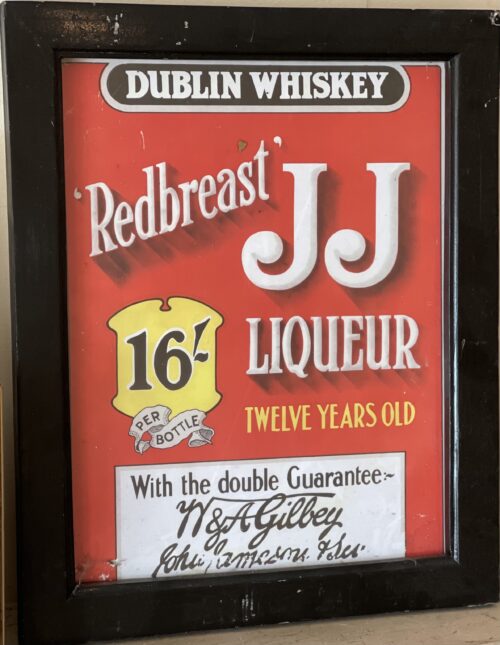
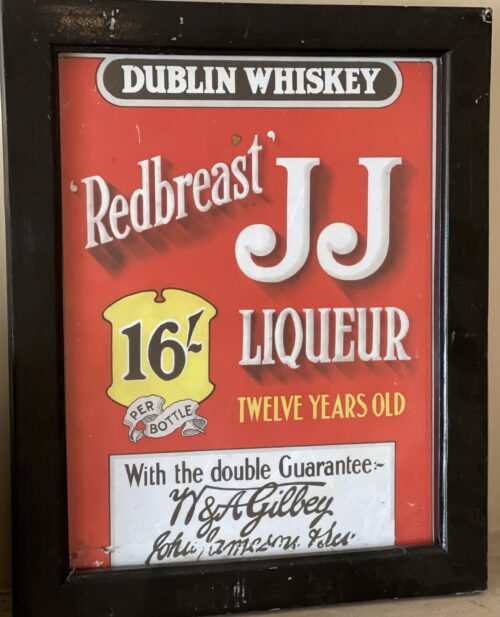




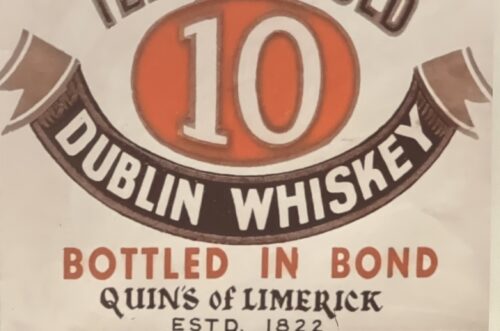
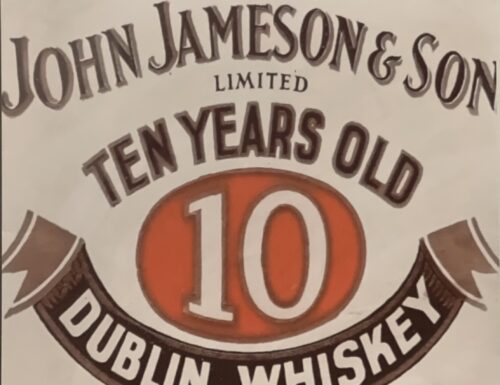





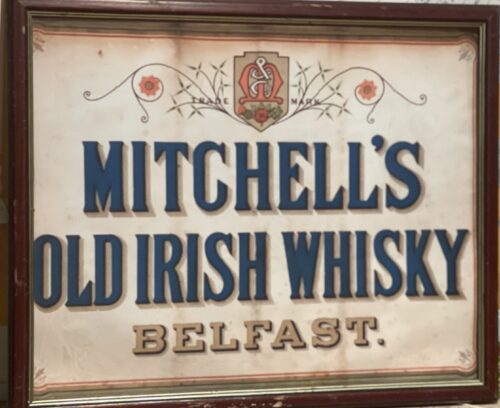
 Some original and rare Mitchell mirrors are still surviving today and can be found in some pubs in and around Belfast today
Some original and rare Mitchell mirrors are still surviving today and can be found in some pubs in and around Belfast today
 Some other examples of Mitchell Mirrors which were mass produced for advertising their products
Some other examples of Mitchell Mirrors which were mass produced for advertising their products




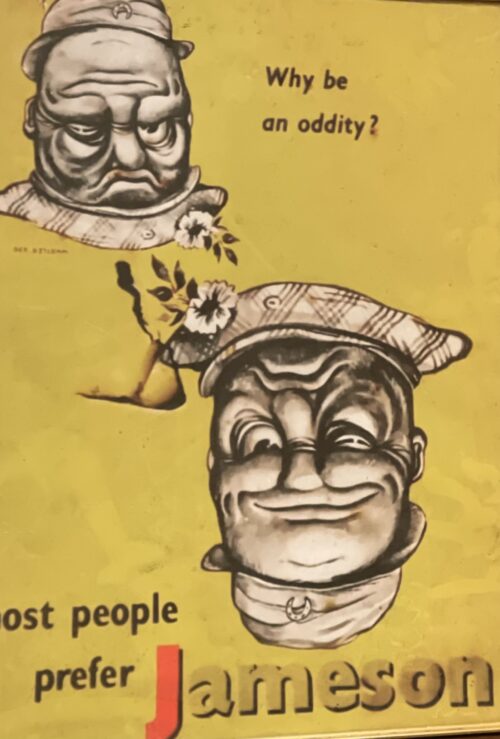
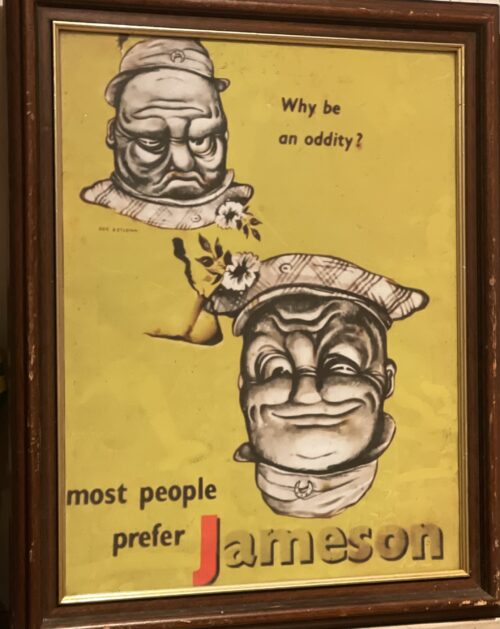





.jpg)
 After retirement to stud his popularity continued. He starred in the film Wild Boy (based on his life-story) in 1934 which was shown in cinemas all across the UK. He was in huge demand on the celebrity circuit, opening shops, attending big races and even rubbing shoulder with royalty (such as the King and Queen) at charity events. When he died in 1939 aged 12, his owner donated his body to the British Natural History Museum in London. And Mick`s fame has continued ever since. In 1981 he was inducted into the American Hall of Fame (International Section). In 1990 English author Michael Tanner published a book, Mick The Miller - Sporting Icon Of the Depression. And in 2011 the people of Killeigh erected a monument on the village green to honour their most famous son. Mick The Miller is not just the most famous greyhound of all time but one of the most loved dogs that has ever lived.
After retirement to stud his popularity continued. He starred in the film Wild Boy (based on his life-story) in 1934 which was shown in cinemas all across the UK. He was in huge demand on the celebrity circuit, opening shops, attending big races and even rubbing shoulder with royalty (such as the King and Queen) at charity events. When he died in 1939 aged 12, his owner donated his body to the British Natural History Museum in London. And Mick`s fame has continued ever since. In 1981 he was inducted into the American Hall of Fame (International Section). In 1990 English author Michael Tanner published a book, Mick The Miller - Sporting Icon Of the Depression. And in 2011 the people of Killeigh erected a monument on the village green to honour their most famous son. Mick The Miller is not just the most famous greyhound of all time but one of the most loved dogs that has ever lived.
